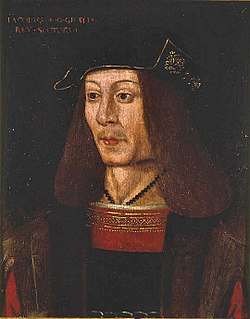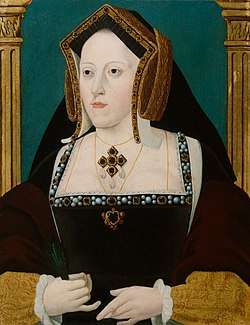John Shaa
Sir John Shaa or Shaw (died c.1503) was a London goldsmith. He served as engraver and later joint Master of the Mint, and as Sheriff and Lord Mayor of London. While Lord Mayor he entertained ambassadors from Scotland, and was among those who welcomed Catherine of Aragon to England. He is mentioned in a poem by William Dunbar.
Sir John Shaa | |
|---|---|
| Died | c.1503 |
| Buried | Church of St Thomas of Acres, London |
| Spouse(s) | Margaret Ilam |
| Issue
Edmund Shaa Reynold Shaa Thomas Shaa Audrey Shaa Juliana Shaa | |
| Father | John Shaa |
| Mother | unknown |
Family
John Shaa was the son of John Shaa of Rochford, Essex, and the nephew and eventual heir of Sir Edmund Shaa, Lord Mayor of London in 1482, whose son, Hugh Shaa, had died without male issue.[1][2] Shaa was also the nephew of Ralph Shaa (d.1484), noted for having preached a sermon at Paul's Cross impugning the legitimacy of Edward IV's children, including his heir, Edward V.[1]
Shaa had a sister, Elizabeth (d. 21 August 1503), who married William Poyntz (d.1504), esquire, of North Ockendon, Essex, by whom she had four sons and two daughters.[3][4][5][6]
Career


Shaa was a London goldsmith. From 1462 until 1483 his uncle, Edmund, also a goldsmith, had been engraver to the Royal Mint. Sir John Shaa succeeded him in the post, and served for several years as engraver until on 20 November 1492 he and his fellow goldsmith, Sir Bartholomew Rede, were appointed joint Masters of the Mint.[7]
Shaa's sales of silver and gold plate to Henry VII are recorded in the privy purse expenses, and on two occasions he was also paid for furnishing Georges for the Order of the Garter. His financial dealings with Henry VII were on a considerable scale. On 13 January 1499 he was reimbursed £667 2s 11d for supplying New Year's gifts and for the 'making of divers jewels and setting and polishing of stones', as well as for funds supplied to 'Master Seymour' for the 'works at Windsor'.[8]
Shaa was elected Member of Parliament for City of London in 1495 and Sheriff of London in 1496-7,[9][10] and with his fellow Sheriff, Richard Haddon, was among those dubbed knight in June 1497 by Henry VII at the foot of London Bridge after the Battle of Blackheath.[11]
In 1501 Shaa was elected Lord Mayor. During his term of office, ambassadors were sent from Scotland to arrange the marriage of Henry VII's elder daughter, Margaret Tudor, with James IV, King of Scotland. At a banquet hosted by Shaa for the ambassadors in Christmas week in December 1501, the poet William Dunbar declaimed verses in honour of the City of London which included these lines in praise of Shaa:[12]
London, thou art of Townes A per se . . .
Thy famous Maire, by pryncely governaunce,
With swerd of justice, thee rulith prudently.
No Lord of Parys, Venyce, or Floraunce
In dignytie or honoure goeth to hym nye.
He is exempler, loode-ster, and guye;
Principall patrone and roose orygynalle,
Above all Maires as maister moost worthy:
London, thou art the flour of Cities all.
During Shaa's term as Lord Mayor, Catherine of Aragon arrived in London as the bride of Henry VII's eldest son, Arthur, Prince of Wales. Shaa was part of the deputation of London civic authorities and members of the livery companies who were instructed to meet her ship 'in their several barges, after their manner accustomed, at Deptford', and to 'hail and salute her in the best manner they can'.[13]
While he was Lord Mayor, Shaa instituted a 'court of requests' in the City of London to administer justice more equitably. It proved unpopular, as it was said to have favoured the poor more than 'justice and good law required'.[14][15]
During his term as Lord Mayor, Shaa caused a kitchen to be added to the London Guildhall. He was said to have been 'the first that kept his feast there'.[16][10] He also instituted another tradition, the procession from the Guildhall to the state barge on which the Lord Mayor travelled to Westminster to be sworn.[10]
Shaa was appointed for a second term as MP in 1503,[9] though as Parliament did not assemble until 25 January 1504 he may have died before attending. He made his will on 26 December 1503, which was proved 14 May 1504, and was buried in the Mercers' chapel in the church of St Thomas of Acres.
Sir John Shaa's arms were Argent, a chevron between three lozenges ermine.[17]
Marriage and issue
In 1479 Shaa married Margaret Ilam, the daughter of a London mercer, Thomas Ilam (d.1482), and Jane Verdon,[18] by whom he had three sons and several daughters, including:[19]
- Edmund Shaa of Horndon on the Hill, Essex, eldest son and heir, who married Lora Wentworth, the daughter of Sir Roger Wentworth (d. 9 August 1539) and Anne Tyrrell, by whom he was the father of Alice Shaa, wife of William Poley.[17][20][21]
- Reynold Shaa.
- Thomas Shaa.[17][21]
- Audrey or Etheldreda Shaa, who married firstly Sir John Shaa's ward, John Writtle; secondly William Ayloffe (d.1517), a Bencher of Lincoln's Inn, by whom she was the grandmother of William Ayloffe (d.1584), Justice of the Common Pleas;[22][21] and thirdly Sir John Gainsford (d.1540) of Crowhurst, Surrey, by whom she had one son, John Gainsford, who died without issue, and five daughters, including Audrey Gainsford, who married firstly George Taylor of Lingfield, Surrey; secondly Sir George Harper; and thirdly George Carleton.[23][24][25][26][27]
After the death of Sir John Shaa, his widow, Margaret (née Ilam), married, as his second wife, Sir John Raynsford of Colchester and Bradfield Hall, Essex, by whom she had a daughter, Julian Raynsford, who married Sir William Waldegrave of Smallbridge, Suffolk.[28]
See also
- List of Sheriffs of the City of London
- List of Lord Mayors of London
- City of London (elections to the Parliament of England)
Notes
- Tucker 2004.
- Middleton 1906, p. 54.
- Metcalfe 1878, p. 91.
- Burke 1836, p. 538.
- Richardson IV, 2011 & p-385.
- According to Richardson, she was the sister of Sir Edmund Shaa.
- Craig 1953, pp. 89, 98.
- Laing 1834, p. 300.
- "Chronological list of aldermen: 1302-1400". British History Online. Retrieved 7 October 2016.
- Beaven, Alfred B., The Aldermen of the City of London, Vol. II (London: Eden Fisher & Co. Ltd., 1913 Archived 12 February 2012 at the Wayback Machine Retrieved 23 June 2013.
- Shaw 1906, p. 30.
- Laing 1834, pp. 272–7.
- 1778, pp. 5–6.
- Cavill 2009.
- Justice in the City Retrieved 23 June 2013.
- Wheatley 1811, p. 170.
- Metcalfe 1878, p. 486.
- Jane Verdon (d. February 1521+), A Who’s Who of Tudor Women: U-V, compiled by Kathy Lynn Emerson to update and correct Wives and Daughters: The Women of Sixteenth-Century England (1984) Retrieved 23 June 2013. Archived 11 Jun 2013 at the Wayback Machine. Retrieved 4 Jan 2019. See also: The Ancestry of Oliver Mainwaring: Shaa Retrieved 4 Jan 2019.
- Wedgwood 1936, p. 758.
- Richardson II 2011, p. 463.
- Howard & Armytage 1869, p. 77.
- Metcalfe 1879, p. 543.
- Howard 1874, pp. 326–7.
- French 1865, p. 60.
- Collinson 2004.
- Harper, George (1503–58), of Sutton Valence, Kent and London, History of Parliament Retrieved 14 December 2013.
- Carleton, George (1529–90), of Overstone, Northamptonshire, Wisbech and Coldham, Isle of Ely, History of Parliament Retrieved 10 December 2013.
- Richardson I 2011, p. 565.
References
- Baker, J.H. (2004). "Ayloffe, William (c.1535–1584)". Oxford Dictionary of National Biography (online ed.). Oxford University Press. doi:10.1093/ref:odnb/939. (Subscription or UK public library membership required.)
- Burke, John (1836). A Genealogical and Heraldic History of The Commoners of Great Britain and Ireland. III. London: Henry Colburn. p. 538. Retrieved 23 June 2013.CS1 maint: ref=harv (link)
- Cavill, P.R. (2009). The English Parliaments of Henry VII 1485–1504. Oxford: Oxford University Press. ISBN 9780191610264. Retrieved 23 June 2013.CS1 maint: ref=harv (link)
- "Certain Notes Taken Out of the Entertainment of Katherine, Wife of Arthur, Prince of Wales, October 1501". Miscellaneous State Papers From 1501 to 1726. London: W. Strahan. 1778. pp. 5–6. Retrieved 23 June 2013.CS1 maint: ref=harv (link)
- Condon, M.M. (2004). "Bray, Sir Reynold (c.1440–1503)". Oxford Dictionary of National Biography (online ed.). Oxford University Press. doi:10.1093/ref:odnb/3295. (Subscription or UK public library membership required.)
- Craig, John (1953). The Mint: A History of the London Mint From A.D. 287 to 1948. Cambridge: Cambridge University Press. pp. 89, 98. ISBN 9780521170772. Retrieved 23 June 2013.CS1 maint: ref=harv (link)
- French, G.R. (1865). "A Brief Account of Crowhurst Church, Surrey, and Its Monuments". Surrey Archaeological Collections. London: Lowell Reeve & Co. III: 39–62. Retrieved 15 December 2013.CS1 maint: ref=harv (link)
- Howard, Joseph Jackson; Armytage, George John, eds. (1869). The Visitation of London. I. London: Harleian Society. p. 77. Retrieved 23 June 2013.CS1 maint: ref=harv (link)
- Howard, Joseph Jackson, ed. (1874). "The Visitation of Surrey". Surrey Archaeological Collections. London: Wyman & Sons. VI: 326–7. Retrieved 15 December 2013.CS1 maint: ref=harv (link)
- Laing, David (1834). The Poems of William Dunbar. I. Edinburgh: Laing and Forbes. pp. 272–7, 297–300. Retrieved 23 June 2013.CS1 maint: ref=harv (link)
- Metcalfe, Walter C., ed. (1878). The Visitations of Essex. XIII. London: Harleian Society. pp. 91, 486. Retrieved 23 June 2013.CS1 maint: ref=harv (link)
- Metcalfe, Walter C., ed. (1879). The Visitations of Essex, Part II. XIV. London: Harleian Society. p. 543. Retrieved 23 June 2013.CS1 maint: ref=harv (link)
- Middleton, Thomas (1906). "Sir Edmund Shaa". Legends of Longdendale. Hyde: Fred Higham. pp. 49–54. Retrieved 23 June 2013.CS1 maint: ref=harv (link)
- Richardson, Douglas (2011). Everingham, Kimball G. (ed.). Magna Carta Ancestry: A Study in Colonial and Medieval Families. I (2nd ed.). Salt Lake City. p. 565. ISBN 978-1449966379.
- Richardson, Douglas (2011). Everingham, Kimball G. (ed.). Magna Carta Ancestry: A Study in Colonial and Medieval Families. II (2nd ed.). Salt Lake City. ISBN 978-1449966386.
- Richardson, Douglas (2011). Everingham, Kimball G. (ed.). Magna Carta Ancestry: A Study in Colonial and Medieval Families. IV (2nd ed.). Salt Lake City. ISBN 978-1460992708. Retrieved 23 June 2013.
- Shaw, William A. (1906). The Knights of England. II. London: Sherratt and Hughes. p. 30. Retrieved 23 June 2013.CS1 maint: ref=harv (link)
- Tucker, P. (2004). "Shaw , Sir Edmund (d. 1488)". Oxford Dictionary of National Biography (online ed.). Oxford University Press. doi:10.1093/ref:odnb/25248. (Subscription or UK public library membership required.) The first edition of this text is available at Wikisource: . Dictionary of National Biography. London: Smith, Elder & Co. 1885–1900.
- Wedgwood, Josiah C. (1936). History of Parliament: Biographies of the Members of the Commons House 1439–1509. London: His Majesty's Stationery Office. p. 758.CS1 maint: ref=harv (link)
- Wheatley, Henry Benjamin (2011) [1811]. London Past and Present. Cambridge: Cambridge University Press. p. 170. ISBN 9781108028073. Retrieved 23 June 2013.CS1 maint: ref=harv (link)
External links
- Will of Sir John Shaa or Shaw, alderman and goldsmith, of Saint Thomas Acres, City of London, proved 13 May 1504, PROB 11/14/156, National Archives Retrieved 23 June 2013
- Will of Sir Edmund Shaa, goldsmith and alderman and late mayor, of Saint Thomas Acres, City of London, proved June 1488, PROB 11/8/187, National Archives Retrieved 23 June 2013
- Will of Hugh Shaa, proved 18 March 1492, PROB 11/8/657, National Archives Retrieved 23 June 2013
- Will of George Taylor of Lingfield, Surrey, proved 28 January 1544, PROB 11/30/20, National Archives Retrieved 15 December 2013
- Will of Sir John Gainsford, proved 29 October 1540, PROB 11/28/264, National Archives Retrieved 15 December 2013
- The Ancestry of Oliver Mainwaring: Shaa Retrieved 4 Jan 2019
- Thurrock Heritage Factfiles: 45 The Horndon Woolmarket Retrieved 23 June 2013
- John Strype's A Survey of the Cities of London and Westminster Retrieved 29 June 2013